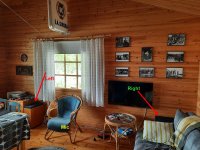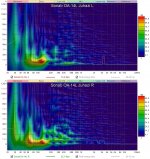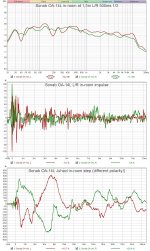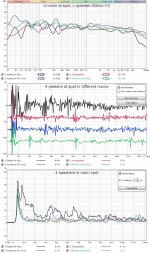Well :no! If you say 3 way, better, because...stereo image in a room is with well designed 2 way speakers ie. LS3-5
I rarely get to buy seats in the middle of the concert hall. Those are either too expensive or reserved for season tickets. So I have to settle for a less than perfect live performanceTheres no such thing as a perfect reproduction of a live performance, but the closest you'll get is with a decent pair of traditional midfield monitors sitting in the sweet spot of the stereo triangle.
There is nothing fake about spaciousness and the unnaturally low level when listening to a conventional stereo recording in a room. This is particularly apparent with recordings of orchestral music in concert halls. Fiddling about with the recording isn't going to help because the ear/brain perceives it primarily by a difference in arrival time at the ears. To enhance it the speakers need to strengthen the sound coming from the sides but without strong early reflections and without the frequency response of the reflections being mangled. To do this well while maintaining the quality of image and tonal balance of a conventional speaker is likely to be impossible. But it can be enhanced as can be heard by listening to reasonably setup MBLs, Sonabs and no doubt one or two other omni speakers. It is inevitably going to be strongly room and position dependent. So what are the rules for doing it well?
I completely agree about the pitfalls of trying to get close to accurate reproduction of recorded live music. There's so much to go wrong and it's alot of theoretical "what ifs". The only reason I harp on the subject of rear radiating HF is that it causes more issues than it solves, plus I've never heard it work well in the practical world.
I also agree that you need realistic playback level capability in addition to it all for the necessary dynamics range, where a 3 way system has its place. Thats why I usually favor a 3 way setup over anything else, or at least a 2 way with stereo subs, although that has its pitfalls as well.
I've always been a fan of large 3 ways with a 15" LF driver or better yet horn loaded.
The reason I bring up the LS3/5 is its natural tonality and believable playback as a compact everyday speaker you can live with in a smaller setting, specifically if you treat them as monitors as they are intended to be used. In that situation they really deliver the goods and you can listen all day without fatigue. Usually if a speaker sounds interesting at first listen, there is something that sticks out in a bad way over a longer period of time which grates on your ears. Multi HF driver speakers for home use usually have this trait. The exception is a well designed shaded array, which is complicated to pull off successfully and it requires optimal processing and design to overcome combing issues.
In the end, large high efficiency 3 ways powered by pristine class A amplification are usually the easiest way to soothing my musical heart and soul.
I also agree that you need realistic playback level capability in addition to it all for the necessary dynamics range, where a 3 way system has its place. Thats why I usually favor a 3 way setup over anything else, or at least a 2 way with stereo subs, although that has its pitfalls as well.
I've always been a fan of large 3 ways with a 15" LF driver or better yet horn loaded.
The reason I bring up the LS3/5 is its natural tonality and believable playback as a compact everyday speaker you can live with in a smaller setting, specifically if you treat them as monitors as they are intended to be used. In that situation they really deliver the goods and you can listen all day without fatigue. Usually if a speaker sounds interesting at first listen, there is something that sticks out in a bad way over a longer period of time which grates on your ears. Multi HF driver speakers for home use usually have this trait. The exception is a well designed shaded array, which is complicated to pull off successfully and it requires optimal processing and design to overcome combing issues.
In the end, large high efficiency 3 ways powered by pristine class A amplification are usually the easiest way to soothing my musical heart and soul.
You are referring to the oa-5? 1960s?The closest way of simplicity in reproducing a lifelike stereo image in a room is with well designed 2 way speakers ie. LS3/5 BBC style monitors. They still are a very good design by today's standards, especially with all the newer refinements in drivers and crossover design.
I'll say this again until I'm in my grave - rear firing tweeters create a fake illusion of spaciousness and exaggerated image. The bose concept is just a gimmick and it always will be. Using multiple tweeters only works if they're arrayed properly. A dipole system with front and rear tweeters needs to have both like drivers emminatiing sound from the same point source on both sides in order to mimick an omni sound source with correct timing of the HF wavefront. Ideally it should be 2 fullrange drivers radiating in phase from the same point.
People in favor of rear radiating HF drivers tend to argue that a recorded instrument radiates sound in all directions. While that is true in theory, the actual radiated sound has different frequency and loudness balance at varying angles all around the instrument(s) not the identical sound at every angle as heard from the front of the instrument. This means you can't accurately reproduce the instruments in a live performance in the original acoustical space by simply replicating the front radiated playback signal with a rear firing driver. Depending on which micing technique is used to capture the performance, the acoustical space and its signature is already accounted for and included in the recording. Throwing the sound in various directions in a new acoustical listening space isn't going to faithfully recreate the original performance. Theres no such thing as a perfect reproduction of a live performance, but the closest you'll get is with a decent pair of traditional midfield monitors sitting in the sweet spot of the stereo triangle.
or the oa12 - oa-2212, 1970s era?
or the oa51, 1980s era?
i wouldnt call OA speakers a dipole/omni system.
OA51 wallmounted, with only 1 1inch tweeter pointing inwards/upwards and a felt hood to reduce dispersion. and 2 10" BR subwoofers
the early ones are quite diffuse and the later ones much less so but still more than a traditional direct radiator but with great sound over a much wider area.
Almost like they are made for a normal living room.
I think you need to go and listen to some OA speakers
Er, one without acoustic treatments in a room?What is a "regular home"?
My uncle in Munich had OA12s. They sounded pretty darn good. IOW "sehr gut". I remember hearing Meddle from Pink Floyd for the first time on his system. It was impressive, even as a 12 yr old kid not understanding much about hifi.You are referring to the oa-5? 1960s?
or the oa12 - oa-2212, 1970s era?
or the oa51, 1980s era?
i wouldnt call OA speakers a dipole/omni system.
View attachment 1073804
OA51 wallmounted, with only 1 1inch tweeter pointing inwards/upwards and a felt hood to reduce dispersion. and 2 10" BR subwoofers
the early ones are quite diffuse and the later ones much less so but still more than a traditional direct radiator but with great sound over a much wider area.
Almost like they are made for a normal living room.
I think you need to go and listen to some OA speakers
I've had a pair of OA-14L for some 20 years, most of the time at my summer cabin. Source is car-stereo set (with broken cd-player). The sound is ok, good bass and uniform soundfield with poor stereo imaging.
Some time ago I took my laptop and umik-1 along and run some sweeps. I held the mic by hand, approximately at "spot". I didn't have time to look at measurements closer then, and now I noticed that speakers have different polarity (my wiring mistake) I tried to listen to mono, but there are so many early reflections, that difference is impossible to hear. I am planning to make outdoor off-axis measurements later on, during next 20 years...



Some time ago I took my laptop and umik-1 along and run some sweeps. I held the mic by hand, approximately at "spot". I didn't have time to look at measurements closer then, and now I noticed that speakers have different polarity (my wiring mistake) I tried to listen to mono, but there are so many early reflections, that difference is impossible to hear. I am planning to make outdoor off-axis measurements later on, during next 20 years...



Yes I have thought about modding tweeters and going active-dsp, but so far I'm happy the way they are. The room dictates positioning and any other type of speaker would be even more problematic! And the cabin doesn't have any use or heating during the winter 5 months!
Here comparison of spot measurements to three other speakers I have done or modded (3-way actice-dsp). All others also have sealed bass and measure almost flat 30-15000Hz pseudo-anechoic. These are just single sweeps, averaged spl would be closer to each other, but now I wanted to look at impulse.

Here comparison of spot measurements to three other speakers I have done or modded (3-way actice-dsp). All others also have sealed bass and measure almost flat 30-15000Hz pseudo-anechoic. These are just single sweeps, averaged spl would be closer to each other, but now I wanted to look at impulse.

For me the thread has not thrown up sufficient rules/guidance (or even what Ortho Acoustic means technically rather than as a marketing term) to quantitatively understand the trade-offs and hence have a go at outlining a speaker design. Is anyone aware of something I may have missed? My interest is in a speaker that creates an enhanced sense of spaciousness with a stereo signal with little degradation in timbre and modest loss of imaging.
Does anyone else currently have an interest in such speakers to the extent of wanting to build one?
Is anyone else interested in working out a set of rules to quantify the trade-offs in order to help design such a speaker? Clearly this will need to involve the acoustics of the room as well as the speaker making the simulations trickier than usual.
Does anyone else currently have an interest in such speakers to the extent of wanting to build one?
Is anyone else interested in working out a set of rules to quantify the trade-offs in order to help design such a speaker? Clearly this will need to involve the acoustics of the room as well as the speaker making the simulations trickier than usual.
I have been interested in using Stig's modern 6,5" replacement in an own build, but there are no measurements known to man out there
https://www.hifikit.se/komponenter/hogtalarelement/hifi/b65oa-iv.html
https://www.hifikit.se/komponenter/hogtalarelement/hifi/b65oa-iv.html
You might also like to have a look at the AudioKinesis speakers - another approach that involves thinking about the acoustical environment plus the speakers, something that seems to be forgotten these days
Thanks for the pointer but I had a look but could see nothing relevant. Were you thinking of something specific?
I have been interested in using Stig's modern 6,5" replacement in an own build, but there are no measurements known to man out there
https://www.hifikit.se/komponenter/hogtalarelement/hifi/b65oa-iv.html
I haven't looked but you might be able to infer some issues/improvements from the measurements on the Carlsson Cult site which seems a bit more engineering orientated than some of the other sites. Do you know if the Stig Carlsson Foundation has a web presence?
By not being constrained to work with existing speaker hardware I would expect to be using a combination of standard range drivers from the usual suspects of SEAS, Scan-Speak, SB Acoustics, etc... I would also use an active crossover since development will be cumbersome without and I strongly suspect the higher degree of room dependence will dictate a more adjustable speaker than normal. This is of course subject to simulations showing how to go about things which is likely but not certain. It will take a while to put together such simulations so deciding on suitable hardware is not imminent.
The "Use your illusion 2" speaker I've made, puts Polk's SDA on top of OB's dipole, on top of stereo. I understand all 3 are a perceptual illusion, as much as what the brain does with the sound, from what the speaker arrangement is doing. The enhancement of the stereo presentation is dipole radiation, which many listeners love, while some do not. Then the illusory widening of the stereo image via the SDA cancellation effect; again some love (as Polk continues to market this arrangement I believe) some do not.My interest is in a speaker that creates an enhanced sense of spaciousness
I have to believe this ortho arrangement of HF drivers presents something similar; you like it or you dont. Kinda like Bose's direct plus reflected sound. Or Ohm's Walsh driver. Heck, I had a Pluvia 7 HD playing while facing down, firing into a hunk of porous foam and even that threw a nice sense of spaciousness into the music, radiating 360 from the back side of the cone facing up.
The "Use your illusion 2" speaker I've made, puts Polk's SDA on top of OB's dipole, on top of stereo. I understand all 3 are a perceptual illusion, as much as what the brain does with the sound, from what the speaker arrangement is doing. The enhancement of the stereo presentation is dipole radiation, which many listeners love, while some do not. Then the illusory widening of the stereo image via the SDA cancellation effect; again some love (as Polk continues to market this arrangement I believe) some do not.
I have to believe this ortho arrangement of HF drivers presents something similar; you like it or you dont. Kinda like Bose's direct plus reflected sound. Or Ohm's Walsh driver. Heck, I had a Pluvia 7 HD playing while facing down, firing into a hunk of porous foam and even that threw a nice sense of spaciousness into the music, radiating 360 from the back side of the cone facing up.
Interesting project which I had missed because I do not tend to read the single driver forum. I am not familiar with SDA but after a very brief google it seems to be addressing broadening of the source locations in front of you which is a form of spaciousness but not the aspect I wish to enhance. I am seeking more the perception of being inside or enveloped by sound which one would tend to get from the side speakers in a 5.1 recording. It obviously cannot be achieved with stereo in the way it can with 5.1 or by music in a hall but I have heard it enhanced by some omni-directional speakers. Although dipoles add to the reflected sound they do it primarily in the axial direction and when orientated typical tend to have a null in the side-to-side direction.
I looked at a pair of used Sonab omni directional speakers a few years ago, they were in lovely condition, but really cheap. I didn't buy them because the honest (!) sales person told me they would only work well in a particular size and layout of listening room. Furthermore, he told me that they really needed their companion Sonab amplifier to enable them to sound their best.
May have been BS but why else would he willingly lose a sale?
Geoff
May have been BS but why else would he willingly lose a sale?
Geoff
- Home
- Loudspeakers
- Multi-Way
- "The only Speakers in the World designed for use in a regular Home" claims Stig Carlsson; Why so rare ?